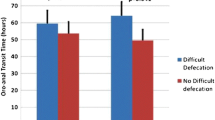Abstract
OBJECTIVES: This study was designed to evaluate whether detailed symptom analysis would help to identify pathophysiologic subgroups in chronic constipation. METHODS: In 190 patients with chronic constipation (age, 53 (range, 18–88) years; 85 percent of whom were women), symptom evaluation, transit time measurement (radiopaque markers), and functional rectoanal evaluation (proctoscopy, anorectal manometry, defecography) were performed. Patients were classified on the basis of objective data from all tests in four different groups (“disordered defecation,” “slow gastrointestinal transit,” “disordered defecation combined with slow-transit stool,” and “no pathologic finding”). RESULTS: In 59 percent of patients, disordered defecation was found, and 27 percent had slow-transit stool. In 6 percent of patients, a combination of both was found; in only 8 percent of patients, there were no pathologic findings. Straining was reported by the vast majority in all groups (82–94 percent). Infrequent bowel movements and abdominal bloating were more common in slow-transit stool (87 and 82 percentvs. 69 and 55 percent, respectively; bothP<0.01). Feeling of incomplete evacuation was more common in disordered defecation (84vs. 46 percent;P<0.0001). However, specificity of these symptoms was discouraging (for slow-transit stool: infrequent bowel movements had a sensitivity of 87 percent and a specificity of 32 percent and abdominal bloating had a sensitivity of 82 percent and specificity of 45 percent; for disordered defecation: feeling of incomplete evacuation had a sensitivity of 84 percent and a specificity of 54 percent). Only the sense of obstruction and digital maneuvers were acceptably specific (79 and 85 percent, respectively) for disordered defecation, but sensitivity was low. CONCLUSIONS: Definition of chronic constipation by infrequent bowel movements alone is of little value; the symptom “necessity to strain” is much better suited (94 percent sensitivity). Specificity of infrequent bowel movements for slow-transit stool was discouraging. Sense of obstruction and digital manipulation for evacuation are relatively specific for disordered defecation but insensitive. Therefore, symptoms of chronically constipated patients are not well suited to differentiate between the pathophysiologic subgroups suffering chronic constipation.
Similar content being viewed by others
References
Stewart RB, Moore MT, Marks RG, Hale WE. Correlates of constipation in an ambulatory elderly population. Am J Gastroenterol 1992;87:859–64.
Karasick S, Ehrlich SM. Is constipation a disorder of defecation or impaired motility? Distinction based on defecography and colonic transit studies. AJR Am J Roentgenol 1996;166:63–6.
Devroede G. Constipation. In: Sleisinger MH, Fordtran JS, eds. Gastrointestinal disease: pathophysiology, diagnosis, managment. Philadelphia: WB Saunders, 1993:837–87.
Drossman DA, Sandler AS, McKee DC, Lovitz AJ. Bowel patterns among subjects not seeking health care. Gastroenterology 1982;83:529–34.
Ting KH, Mangel E, Eibl-Eibesfeldt B, Müller-Lissner S. Is the volume retained after defecation a valuable parameter at defecography? Dis Colon Rectum 1992;35:762–7.
Klauser A, Voderholzer W, Heinrich C, Schindlbeck N, Müller-Lissner S. Behavioral modification of colonic function: can constipation be learned? Dig Dis Sci 1990;35:1271–5.
Lanfranchi GA, Bazzocchi G, Brignola C,et al. Different patterns of intestinal transit time and anorectal motility in painful and painless chronic constipation. Gut 1984;25:1352–7.
Kuijpers HC. Application of the colorectal laboratory in diagnosis and treatment of functional constipation. Dis Colon Rectum 1990;33:35–9.
Duthie GS, Bartolo DC. Anismus: the cause of constipation? Results of investigation and treatment. World J Surg 1992;16:831–5.
Thompson WG, Heaton KW. Functional bowel disorders in apparently healthy people. Gastroenterology 1980;79:283–8.
Sandler RS, Drossman DA, Nathan HP, McKee DC. Symptom complaints and health care seeking behavior in subjects with bowel dysfunction. Gastroenterology 1984;87:314–8.
Ashraf W, Park F, Lof J, Quigley EM. An examination of the reliability of reported stool frequency in the diagnosis of idiopathic constipation. Am J Gastroenterol 1996;91:26–32.
Talley NJ, Weaver AL, Zinsmeister AR, Melton LJ III. Self-reported diarrhea: what does it mean? Am J Gastroenterol 1994;89:1160–4.
Bannister JJ, Davison P, Timms JM, Gibbons C, Read NW. Effect of stool size and consistency on defecation. Gut 1987;28:1246–50.
Reynolds JC, Ouyang A, Lee CA, Baker L, Sunshine AG, Cohen S. Chronic severe constipation: prospective motility studies in 25 consecutive patients. Gastroenterology 1987;92:414–20.
Author information
Authors and Affiliations
Additional information
Supported by Deutsche Forschungsgemeinschaft DFG, Bonn, Germany, Grant Mu 629/2-3.
About this article
Cite this article
Koch, A., Voderholzer, W.A., Klauser, A.G. et al. Symptoms in chronic constipation. Dis Colon Rectum 40, 902–906 (1997). https://doi.org/10.1007/BF02051196
Issue Date:
DOI: https://doi.org/10.1007/BF02051196




